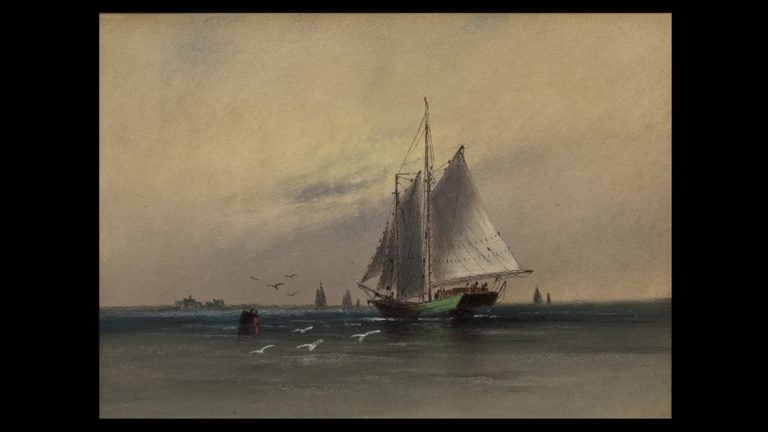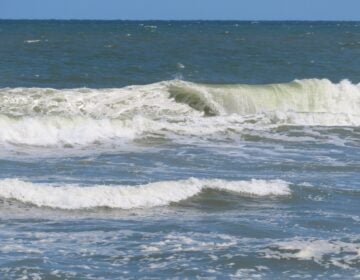Tall sailing ships celebrated in new exhibit at Princeton’s Morven Museum

Two Masted Schooner near Tucker’s Island, New Jersey. William G. Russell (b. 1869).Pastel on paper.
In the wake of Hurricane Sandy there has been a renewed interest in the Jersey Shore. Morven Museum & Garden, whose mission is to educate audiences about the cultural heritage of New Jersey, is presenting The Age of Sail: A New Jersey Collection, through March 23, 2014.
Featuring more than 100 objects from the collection of historian Richard W. Updike, The Age of Sail explores the history of American shipbuilding, sail-making, naval warfare, shipwrecks and rescue and shows the daily life of American sailors through such objects as sea chests and scrimshaw. Engravings and paintings by George Essig (1838-1926), Frederick Schiller Cozzens (1846-1928) and Gerard Rutgers Hardenberg (1855-1915) help to tell the story of New Jersey maritime history.
Shipwrecks, storms, pirates, rumrunners, shark attacks, lighthouses and their keepers make up the stories of the New Jersey seacoast. Updike has been fascinated since his Trenton-area boyhood, developing an interest in nautical things while vacationing at the Jersey Shore. His father took him fishing in the ocean and the bay, and he read the novels of C.S. Forester about Horatio Hornblower, a Royal Navy officer during the Napoleonic Wars. Beginning as a poor seasick midshipman, Horatio Hornblower, through skill and daring, goes on to adventures around the world. He becomes admiral of the fleet and is ultimately knighted.
Updike was fascinated by Patrick O’Brian’s Master and Commander series, also during the Napoleonic Wars. Updike considers himself an armchair sailor. “It’s all in my mind,” he said. “I’m not interested in yachting, my focus is on merchant vessels.”
As a child, Updike visited the Maine Maritime Museum where he saw the Wyoming, the largest schooner ever built. From 1909, the six-masted schooner was 330 feet. “It was bigger than a football field,” says Updike, who was so excited, it inspired him to study nautical history.
While in high school, Updike began his investigations of lighthouses. Always interested in old things and the past, Updike, who taught high school history for 32 years, began frequenting a Bucks County antiques shop in the late 1960s. “It was like a museum, with 11 rooms,” he said. Retired from teaching in 1977, he began volunteering in the antiques shop. The owner was interested in ceramics and paintings and would wander through Europe collecting. “He always phoned me when a container came in,” said Updike. “People came from as far as California and Kansas City to buy.” Learning all he could over 10 years, Updike started his own antiques business at the Shore Antiques Center in Point Pleasant. Specializing in nautical finds, paintings and Early American glass, Updike ran the business for 18 years before opening up shop at the Point Pleasant Antiques Emporium.
“I did it for the love of it,” he said. “It was a way to meet people and chat and expand my horizons.” It also enabled him to expand his collection.
On exhibit at Morven
The Age of Sail refers to the period of sea-borne commerce from 1450 to the early 20th century. The artwork shows the sailing vessels, from schooners to square riggers, and helps to understand the lives of the sailors.
Sea chests also tell the stories of the sailors, whose worldly possessions would be contained in the trunk. A mid 19th-century “ditty box” is a smaller trunk that carried a sailor’s personal effects – tobacco, writing implements, a Bible and other uplifting tracts, needles for patching sails. A till was a smaller box within a box. There are six sea chests from the 18th and 19th centuries, as well as a Spanish Captain’s Chest, circa 1500, decorated with carvings of painted galleons. The lid is decorated inside by pen work and stippling. Chests of these dimensions were used to ship silver coins and cob pieces to Spain from mints in the colonies of the Western Hemisphere.
Many New Jersey ships had billet heads, according to Updike. This was a “poor man’s figurehead,” a decoration for the bow of the ship that was not as elaborately carved as a figurehead. Figureheads could be swept away in storms, says Updike, but even the billet heads were ornate with double carvings representing waves. The decorative touch was a carry over from ship carvers of the 1600s “who went wild with gilded decorations. There were famous ship carvers from England for war and commercial ships. But these were expensive and unnecessary and we gradually got away from them, so they are very rare.” Updike cites one that sold for $10,000, as reported in Maine Antiques Digest.
The Age of Sail includes navigating instruments, such as a 1790 single draw telescope. “You focus by pulling in and out.”
Among the objects in The Age of Sail is a grog tub, measure and mug. Crewmembers of the vessels in Britain’s Royal Navy were accustomed to a daily ration of rum, we learn, and in 1740 Admiral Edward Vernon, out of concern for intoxicated sailors, ordered that the spirits be diluted with water – a policy that continued for more than 200 years. Vernon, because he habitually wore a grogram cloak, was nicknamed “Old Grog” and his name became attached to the diluted alcoholic mixture. Mount Vernon was also named for Admiral Vernon.
There are cannonballs from the American Revolution and a bronze swivel gun. Rigging knives, tobacco and snuff boxes evoke Captain Jack Sparrow.
A ship’s wheel from an 1823 shipwreck off Point Pleasant, another that was part of a rum-running schooner seized by the Coast Guard near Atlantic City during the Prohibition era, a medicine chest from the brig Philadelphia, 19th-century cast iron stoves and belaying pins, pulley blocks salvaged from the 1852 wreck of the Powhattan off the coast of Manahawkin – Updike collected well.
He is not only a wealth of nautical information, but also a walking dictionary of expressions derived from nautical use. As ships were raided for materials, such as the fastenings that held the wood together, insurance became available in the second half of the 18th century. When insurance inspectors came to determine the insurance rate, “A1” referred to the top quality of the fastenings. “Barratry” is the deliberate wrecking of a ship for its insurance.
“By and large” is what a captain would tell the helmsman if he wanted him to sail near to something but not close to it (whereas “close and by” refers to sailing near and close). By and large, The Age of Sail at Morven is the most comprehensive collection of nautical artifacts this region has seen.
_________________________________________________
The Artful Blogger is written by Ilene Dube and offers a look inside the art world of the greater Princeton area. Ilene Dube is an award-winning arts writer and editor, as well as an artist, curator and activist for the arts.
WHYY is your source for fact-based, in-depth journalism and information. As a nonprofit organization, we rely on financial support from readers like you. Please give today.





